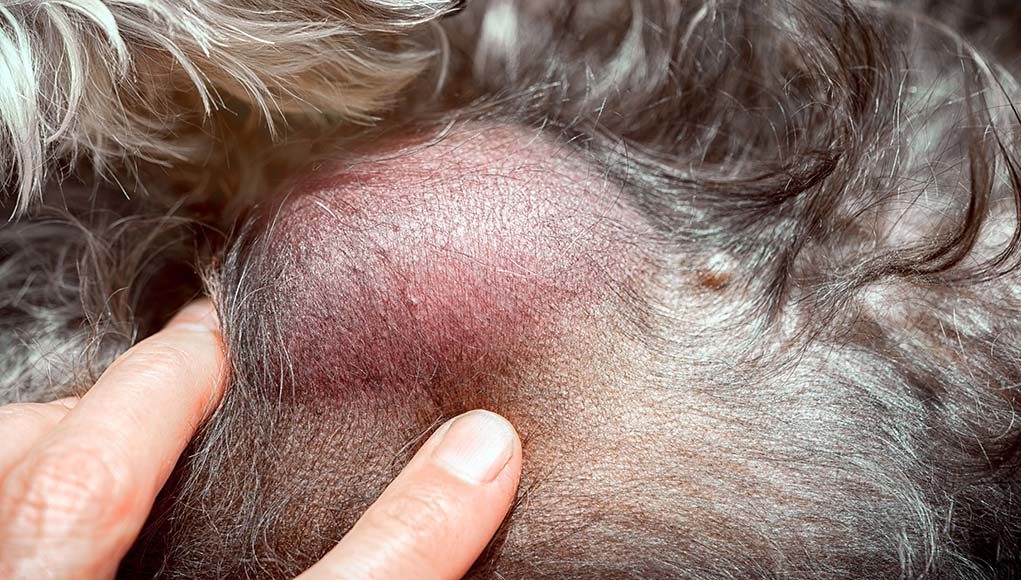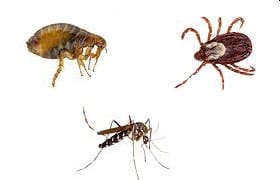Dogs enjoy snuffling around outside, and every hidden nook and scent in the breeze piques their interest. However, they must sometimes keep their noses to themselves to avoid unpleasant encounters with all the creepy crawlies in the world. Ants, for example, can be irritated by excessive sniffing around their colony. However, do you know what fire or red ant bites on dogs look like and how to treat them? According to Albert Ahn, DVM, the veterinary advisor for MYOS Pet, ants can be a nuisance or an emergency, depending on the insect.
Symptoms of Ant Bites on Dogs
So, how do ant bites look on a dog? “They’re usually raised, red, swollen lesions on the skin,” Ahn explains. “These skin lesions may contain pus in some cases.” This is how they appear on a human, which is similar to how they may appear on your dog.
Ant bites on dogs are common on the paws, lower legs, and snout, but can be difficult to detect due to the thickness of their fur. So what you’re looking for are other serious warning signs of trouble, such as:
Related Article: Can Dogs Eat Pickles
- Constant limping or pawing at their nose, or pain in one area of their body.
- Weakness, swelling of the face, and difficulty breathing. Ahn believes they are having an allergic reaction. Not all dogs react in this manner to insect bites, but some do.
- Symptoms that worsen over time, such as pale gums, vomiting, or collapse. “These are symptoms of anaphylaxis,” says Ahn. “Anaphylactic shock necessitates immediate veterinary attention.”
Because fire or red ants attack in groups and coordinate their stings, their bites are more likely to cause anaphylactic shock.
Fortunately, not all ant bites are painful. If the bite is minor, your dog may not show any signs of having been bitten, and the bite will heal on its own. However, keep in mind that dogs’ sensitivity to ant bites varies. What appears to be a harmless ant bite to one dog may cause a severe reaction in another. If you are concerned about your dog’s symptoms following an ant bite, do not hesitate to contact your veterinarian.
How to Treat Ant Bites on Dogs
According to Ahn, if your pet does not have any of the more severe symptoms of ant bites, some simple home remedies may help relieve the discomfort of superficial encounters.
“These include baking soda solutions, lemon juice mixed with baking soda, or apple cider vinegar,” he explains. “A pet parent can also use olive oil or a drop or two of honey to help soothe the itchiness from an ant bite.” Make sure your dog does not lick the bite site; an e-collar can help with this.
To reduce swelling, apply a cold compress or an ice pack wrapped in a towel to the bite site. Any allergic reaction necessitates medical treatment. According to Ahn, depending on the severity, this could include:
Related Article: Can Dogs Eat Coconut
- A steroid to treat anaphylaxis while also providing supportive care such as fluid therapy, anti-vomiting medication, and, in severe cases, oxygen therapy.
- The majority of anaphylactic reactions can be treated within an hour or two. In more complicated cases, hospitalization for up to 24 hours for continuous monitoring may be required.
Fire Ant Bites On Dogs
I discovered fire or red ants the hard way one day while walking my dog when a friend of mine stopped with his car. We were chatting when Kaiser began rolling around on the ground.
It appeared awkward for him to do this at such an inconvenient time, so I encouraged him to get back on his feet. Minutes later, he was back on the ground, jerking frantically as if something serious was happening.
When I looked at him again, I noticed the source of his agitation: there were several fire ants right there! They were biting my poor dog all over! I pushed him away and went home to investigate.
As the ants attempted to climb, it appeared that the majority of the bites were on their legs. I decided to keep a close eye on him while I checked to see if I had any Benadryl on hand in case he had an allergic reaction.
Related Article: Can Dogs Get Poison Ivy?
Shortly after, he began licking the bitten areas. A few licks here and there quickly escalated into obsessive licking and biting that showed no signs of abating. I had to take action!
Why are Red or Fire Ant Bites Harmful to Dogs?
Red ant (also known as fire ant) bites are dangerous to dogs because when they attack, they release alkaloid venom, which can cause an allergic reaction. Individual reactions differ, with some dogs experiencing mild symptoms such as paw chewing and itchy, red skin, while an ant bite can result in death for others.
The same can be said for humans. The size of the dog is important when it comes to pets. A large dog, such as Holly, is less likely to be harmed by a single fire ant sting than a small dog. Dogs are especially vulnerable to fire or red ant bites due to their inquisitive nature, which includes sniffing fire ant mounds in dirt and soil and stepping into their territory.
How Are Fire Ant Bites Treated?
I applied what I knew was a good remedy for pets bitten by bees, wasps, and other nasty stinging creatures once I recognized the bites.
I made a baking soda and water paste and applied it to the wound. Furthermore, I used a sock to keep my dog from licking up the baking soda and made sure he didn’t take it off. Every few minutes, I applied an ice pack wrapped in a towel.
Related Article: How Far Can Dogs Hear: All You Need To Know
The baking soda and water paste acted quickly. I believe the fact that the baking soda was in my freezer (to keep odors at bay) helped even more. He was resting peacefully minutes later, and he ignored the fire ant bites for the rest of the day. I am relieved that no Benadryl was required because I dislike giving medications to dogs.
In severe cases, however, 0.5 to 2 mg of Benadryl per pound is an effective treatment for dogs with ant bites. As with the administration of any over-the-counter medication, it is strongly advised to consult with your veterinarian first.
Kaiser’s legs were covered in whitish-gray bite marks days later. These marks took a long time to fade (several months). Although Kaiser only had a mild reaction, there have been reports of dogs dying from anaphylactic shock.
This usually happens within minutes of being stung. Breathing difficulties, collapse, and respiratory failure are all warning signs. Kaiser still had marks on his leg three months later. It took a long time for them to vanish entirely. Meanwhile, I kept my dogs away from these venomous creatures!
Ant Bites On Dogs Treatment
Keep an eye out for allergic reactions if your dog has been bitten by ants. He may have been bitten by a dangerous type of ant if he exhibits more severe symptoms such as difficulty breathing or disorientation. Excessive inflammation or the development of hives could also cause concern. Take him to the vet right away with his medications. In the first 24 hours after being bitten, keep a close eye on your dog to see if any unusual symptoms emerge.
How to Prevent Ant Bites in Dogs
While your dog may become more cautious of ants after being bitten, there are things you can do to keep your furry friend safe.
Related Article: Can Dogs Eat Peanuts? Is It Safe?
- Keep your dog away from areas where ant colonies may exist. Ants commonly live in soil, bushes, and tree bark.
- You can protect your dog from ants and other harmful insects by using ant repellents. Citronella and lemon are among the most repulsive odors to dogs, but they are also effective insect repellents.
- Keep food in a tightly sealed container. You know how quickly ants appear when you have accidentally left some food out. Keep your home ant-free by using airtight containers.
- Properly dispose of leftovers and thoroughly clean up any crumbs.
- Look around your yard for ant mounds or colonies.
Conclusion
Red ant bites on dogs are generally innocuous and can be treated with first aid and pain relief. Numerous household items can be applied topically to bitten areas to relieve itchiness, irritation, and pain. Benadryl is also a reliable first-aid medication. However, if your dog is prone to allergic reactions or has been bitten by a particularly potent ant, you must keep an eye out for any anaphylactic reactions. Keep an eye out for any unusual symptoms, especially within the first 24 hours. Consult a veterinarian right away if you notice any signs of vomiting, diarrhea, weakness, fever, or respiratory distress.
Frequently Asked Questions
What can I put on my dog for ant bites?
A pet parent can also use olive oil or a drop or two of honey to help soothe the itchiness caused by an ant bite. Make sure your dog does not lick the bite site; an e-collar can help with this. To reduce swelling, apply a cold compress or an ice pack wrapped in a towel to the bite site.
How do I know if my dog was bitten by an ant?
Symptoms that your pet has been bitten by an ant
Ant bites frequently cause pain or swelling at the site of the bite, which can be both unpleasant and irritating for your pet. Here are some of the most common signs that an ant has bitten your pet: Pet suddenly raises a leg or paw. Foot licking or biting.
Are ants harmful to dogs?
Yes. Ants can occasionally make their way into your dog’s food bowl and become part of their meal, though some dogs will refuse to eat their food if they find ants crawling in it. Ants may be a nuisance to you, but they contribute protein and vitamin C to your dog’s diet.
How long do ant bites last on dogs?
If your pet is acting normally, a few stings are usually not a cause for concern. The sting sites should improve within 24-72 hours. Benadryl or diphenhydramine can be given to your pet if he or she is itchy or uncomfortable.






